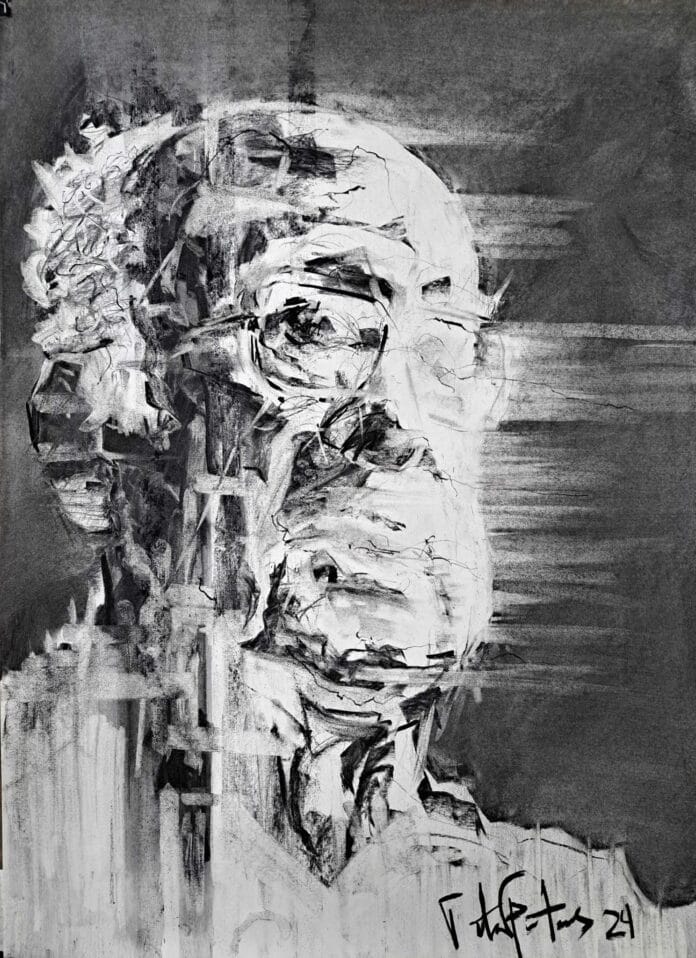George Androutsos was born in 1976 and stands at the intersection of art and intellect. His path as both a visual artist and academic reveals a rare synthesis of creativity, science, and philosophy. Having studied Painting, Physics, and the History of Philosophy at the Aristotle University of Thessaloniki, he brings a deeply analytical yet poetic dimension to his artistic vision. His academic pursuits culminated in a doctoral thesis at the National Technical University of Athens, a testament to his continuous inquiry into the nature of form, meaning, and human perception.
This blending of artistic intuition with scientific curiosity defines Androutsos’s approach to image-making. His works are not merely aesthetic explorations; they are philosophical reflections translated into visual language.
A Career of International Recognition
Over the past decades, Androutsos has established himself as a significant presence in the international art scene. His career includes six solo exhibitions held across major cultural centers such as Athens, Paris, Nice Côte d’Azur, Barcelona, and Tokyo Kanagawa. Each exhibition has offered audiences a glimpse into his evolving exploration of abstraction, emotion, and human form.
Beyond solo presentations, he has participated in dozens of group exhibitions in Greece and abroad, marking a consistent engagement with global dialogues in contemporary art. His drawings have also been selected by international committees for participation in drawing biennials, portrait biennials, and art fairs, affirming the distinctiveness of his style and the universality of his themes.
In recognition of his artistic achievements, Androutsos has received numerous awards and commendations from international art platforms. His works now reside in private collections, and his name regularly appears in catalogs, art journals, and both printed and digital magazines, ensuring his growing visibility among collectors, curators, and scholars.
The Poetry of Painting
George Androutsos usually paints and draws faces in an abstract way using charcoal and chalk on paper. He chose this manner of expression because he believes drawing is the poetry of painting, and it represents the fundamental conflict: black and white, the empty space, and the complete, to move and to stop. All of them are perpetually interwoven in the painting, seeking completion.
This statement encapsulates the core of his aesthetic philosophy. In his hands, drawing becomes a poetic process, a balancing act between presence and absence, creation and erasure. Working primarily with charcoal and chalk, Androutsos embraces the tactile immediacy of these materials, the way they smudge, fade, and reveal. These oppositions mirror the essence of life itself: fleeting yet eternal, defined yet fluid.
His focus on faces rendered in abstraction introduces a dialogue between individuality and universality. The human visage, stripped of literal likeness, transforms into a symbol of emotion, thought, and spiritual tension. Each line becomes a heartbeat; each shadow, a silent echo of consciousness.
Between Black and White: The Space of Reflection
Androutsos’s monochromatic palette is not a limitation; it is liberation. The deliberate choice of black and white invites the viewer to confront purity and contrast without distraction. Through this visual simplicity, he achieves profound complexity. The stark interplay of tones evokes the timeless philosophical oppositions that have long fascinated him: light and darkness, fullness and emptiness, motion and stillness.
In many of his works, the surface of the paper seems alive, marks emerge and recede, like memories surfacing through layers of time. The space between gesture and void becomes a metaphor for the human condition, where clarity and ambiguity coexist.
This exploration aligns seamlessly with his academic background in both Physics and Philosophy, disciplines concerned with matter, energy, and existence. Just as physics seeks to understand the invisible forces shaping the world, Androutsos’s art examines the unseen emotional and metaphysical energies that shape the self.
The Artist as Educator
Beyond his studio practice, Androutsos plays a vital role as an educator. For the past two years, he has been seconded to the Department of Theater Studies at the University of Peloponnese, where he teaches drawing and painting. In this setting, he bridges classical artistic disciplines with the expressive language of theater, encouraging students to see visual art as both performance and contemplation.
His dual role as artist and teacher reinforces his belief that art is a living dialogue, a process of continuous discovery shared between creator, viewer, and student. Through education, he extends his philosophy of drawing as poetry into the next generation of thinkers and image-makers.
Searching for Completion
At the heart of George Androutsos’s practice lies an unending search for completion within incompleteness. His works invite contemplation, urging viewers to engage with what lies between the lines, within the silences of his compositions. Each drawing becomes an open-ended question rather than a definitive answer, an invitation to participate in the dance of contrasts that defines existence.
Through the subtle power of charcoal and chalk, Androutsos translates philosophical ideas into visual form, where emotion and intellect merge seamlessly. His art reminds us that creation is not merely about depicting reality, but about unveiling its invisible tensions, its poetic balance, and its eternal oppositions.
Conclusion
George Androutsos stands as a rare figure in contemporary art, an artist, philosopher, and scientist whose works transcend medium and genre. His visual language speaks to the essence of being human: the pull between light and darkness, chaos and harmony, body and spirit. Whether on the walls of international galleries or within the pages of art journals, his drawings continue to whisper the same timeless truth that art, like life, finds beauty in its contradictions.


